Departure Date: September 9 - 23, 2025
Compiled By: Andrew Whittaker
Trip Leaders: Andrew Whittaker, Local Leader
Toll Free: 800.328.8368
Phone: 512.328.5221
Grand Bolivia: Part I 9/9/2025-9/23/2025

https://ebird.org/tripreport/422286
Still one of the South American continent’s best-kept birding secrets, delightful Bolivia is a birder’s paradise, a not-to-be-missed destination. This year’s tour was as sensational as ever—it truly rocked!
As always, we enjoyed magnificent studies of both of Bolivia’s most sought-after endemics, the macaws. First up was the Red-fronted Macaw, with its breathtaking mix of vivid colors; this has to be the most beautiful of all macaws. We followed up with excellent studies of several family groups of the endangered Blue-throated Macaw in the Bolivian Pantanal. In the end, we marveled at no fewer than seven fabulous macaw species!
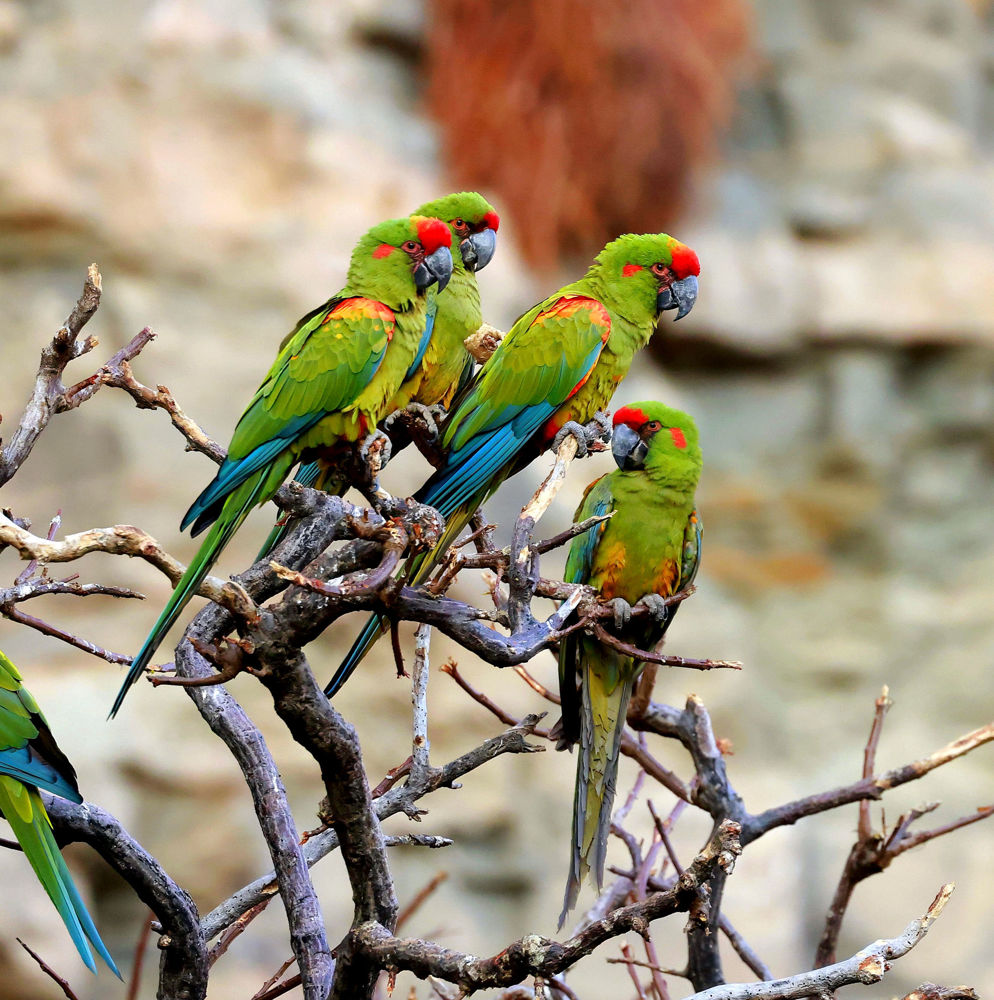
Stunning endemic Red-fronted Macaw was voted top bird © Andrew Whittaker
Throughout the tour, we were enthralled by Bolivia’s incredible variety of habitats, from lush yungas forest, Chaco Serrano, Chiquitania forest, dry interandean valleys, and southern cloud forest to the vast Pantanal wetlands teeming with wildlife. Many of our countless avian highlights were seldom-seen gems of South American birding.

Male Crested Quetzal © Andrew Whittaker
We began our tour in the capital, Santa Cruz, where we met my good friend and co-leader Indio Emiliano. Our excellent new hotel offered up an impressive nightly show as hundreds of Mitred Parakeets came to roost. The lovely gardens and pool produced Chestnut-fronted Macaw, Thrush-like Wren, and Purple-throated Euphonia. On a relaxed afternoon in the botanical gardens, we encountered a feeding Three-toed Sloth and enjoyed great looks at Ferruginous Pygmy-Owl, Gray-cowled Wood-Rail, Green Ibis, Dusky-headed Parakeet, White-wedged Piculet, Great Antshrike, and Fawn-breasted Wren while egrets and Bare-faced Ibis walked carefully among the sunning caimans, including the rare Broad-nosed Caiman. At dusk, several smart Snail Kites came in to roost in the trees.
We left early the next morning for Refugio Los Volcanos, an isolated paradise on the edge of a national park, with just one dirt road winding in and out of this beautiful and secluded valley. The lodge here is surrounded by majestic sandstone cliffs on three sides, with a carpet of rich yungas forest stretching as far as the eye can see—a gobsmacking panoramic vista.

Spectacular Los Volcanes © Andrew Whittaker
The lodge clearing is always a hive of avian activity. We enjoyed flocks of huge and colorful Military Macaws, Blue-headed Parrots, Plush-crested Jays, displaying Crested Oropendolas, and soaring Andean Condors. The sought-after White-throated Piping-Guans amused us with their wing-whirring displays. Even a neat Razor-billed Curassow was seen by the stream. And it was a thrill to find footprints of the incredibly poorly known nocturnal Water Opossum.
The trails through the yungas forest are enchanting, festooned with bromeliads and orchids, and here we tracked down such gems as the Red-necked Woodpecker, Amazonian Motmot, Channel-billed Toucan, Green-cheeked Parakeet, Blue-crowned Trogon, Black-banded Woodcreeper, localized Slaty Gnateater, Yungas Manakin, Blue-naped Chlorophonia, White-necked Thrush, Two-banded and Riverbank warblers, Dusky-green Oropendola, and the rare Blue-browed Tanager.
Sad as we were to leave this paradise, many other exciting birds still awaited us. As we climbed gradually up a lush river valley with spectacular cliffs and forest, the terrain became drier until we emerged into the stark, almost desert-like interandean valleys, a rain shadow area with dramatically different birdlife. Always one of our trip highlights is the conservation lodge created to protect the enigmatic Red-fronted Macaw. And wow: these spectacular macaws did us proud almost immediately, with mega views against the stunning backdrop of sandstone cliffs.
As dusk fell around our lodge, the sunset struck the orange-tinged rimrock and we retired for a well-earned rest. An early rising the next morning found us crossing the river to the base of the cliffs, full of the anticipation of enjoying our prize bird at close range. Immediately we were treated to the magical antics of the Red-fronted Macaws, some fifty individuals staging a truly world-class display at close range. The birds engaged in allopreening, then playfully flew in close to look us over. Unforgettable! We also enjoyed colorful Turquoise-fronted Parrots, Southern Martins, and colonies of Cliff Parakeets on their thorny twig nests.
Very happy, we returned to our lodge for a good breakfast and some birding from the shaded veranda, cool drinks in hand. The active feeders here produced White-fronted Woodpecker, Bolivian Blackbird, Gray-crested Finch, Blue-and-yellow Tanager, and Golden-billed Saltator. A singing White-tipped Plantcutter, Cliff Parakeets, Crowned Slaty Flycatcher (freshly arrived from the Amazon), and pairs of Greater Wagtail-Tyrant showed well. We also enjoyed Spot-backed (Chaco) Puffbirds, Glittering-bellied Emerald, Masked Gnatcatcher, Ultramarine Grosbeak, and Ringed Warbling Finch near the lodge.
 Puffbird Andrew Whittaker_1000.jpeg)
Spot-backed (Chaco) Puffbird © Andrew Whittaker
We retraced our steps to quaint and historic Samaipata, where our delightful family-run lodge nestles above the town. In addition to great hospitality and marvelous food, we enjoyed an exciting new set of birds in habitats ranging from cloud and Tucumano forest to lakes and Chiquitania woodland.
The next day’s dawn was an incredible contrast to the stark valleys. Now we were in the lush southerly cloud forests of the Andes, a truly remarkable birding paradise. Spirits were high as this exciting site came up trumps with great looks at Blue-winged Mountain Tanager and Common Chlorospingus, both of them good candidates for a future split as endemics. After our second breakfast, made by Marco, raptors began to appear, among them displaying Swallow-tailed Kites, a hunting Bat Falcon, and a very confiding Barred Forest-Falcon; color was added by Crested Quetzal and Masked Trogon. Other noteworthy observations included Rothschild’s Swift, Montane Woodcreeper, Buff-banded Tyrannulet, Rufous-bellied Bush-Tyrant, Yungas Warbler, the rare Green-throated Tanager, and the endemic Bolivian Brushfinch.
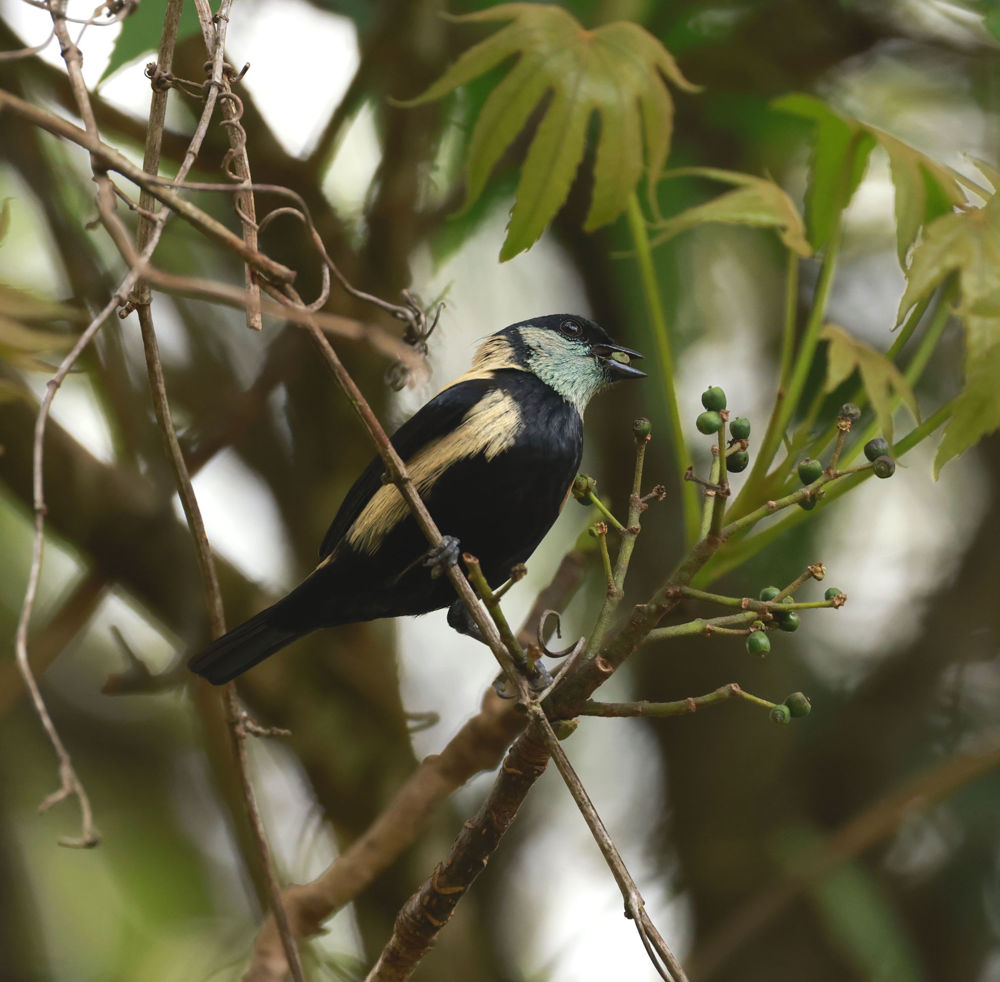
Male Green-throated Tanager © Andrew Whittaker
The next day, we explored Tucumano forest and Chiquitania woodland, starting with wonderful looks at magnificent Cream-backed Woodpeckers, Yungas Guan, Narrow-billed Woodcreeper, Buff-browed Foliage-gleaner, Rufous-capped Antshrike, Ochre-faced Tody-Flycatcher, Orange-headed Tanager, Moss-backed Sparrow, and Black-and-chestnut Warbling Finch. We enjoyed another expertly prepared breakfast on the delightfully forested lakeside.
Other highlights here included the rare Tucuman Parrot, Spot-breasted Thornbirds, Sclater’s Tyrannulet, and Golden-winged Cacique. Best of all, though, was a wonderful pair of obliging and massive Giant Antshrikes that sneaked in to be spotted by sharp-eyed Kimberlee. This largest member of the antbird family showed extremely well, always such a thrill to see.
The next morning, at another interesting cloud forest site, was very productive. Jaque found us some cooperative Blue-banded Toucanets, followed by great studies of male Yungas Manakins on a lek. Other goodies included Tyrian Metaltail, Fork-tailed Woodnymph, Golden-olive Woodpecker, Masked Tityra, Slate-throated Redstart, and the distinctive orange-crowned form of the Saffron-crowned Tanager. A few of us got to see a White-throated Antpitta. After another great lunch in Samaipata, we returned to Santa Cruz for a well-earned afternoon’s rest in our plush hotel.

Blue-banded Toucanet © Andrew Whittaker
Thanks to a later flight schedule, we had time to explore grasslands close to the airport, where noteworthy observations included Greater Rhea, Whistling Heron, Burrowing Owl, Toco Toucan, and Fork-tailed Flycatcher. Our flight then took us to bustling Trinidad, gateway to the famous Bolivian Pantanal. After a delicious meal in our favorite Brazilian restaurant, we checked in to our comfortable base for the night.
We left before dawn with our local guides to visit a private ranch, always a trip highlight, where we enjoyed the great privilege of more quality time with the fantastic endemic Blue-throated Macaw. There are estimated to be no more than 250 to 350 of these magnificent birds left, and we were extremely blessed to see 12 or 15 birds so, so well!
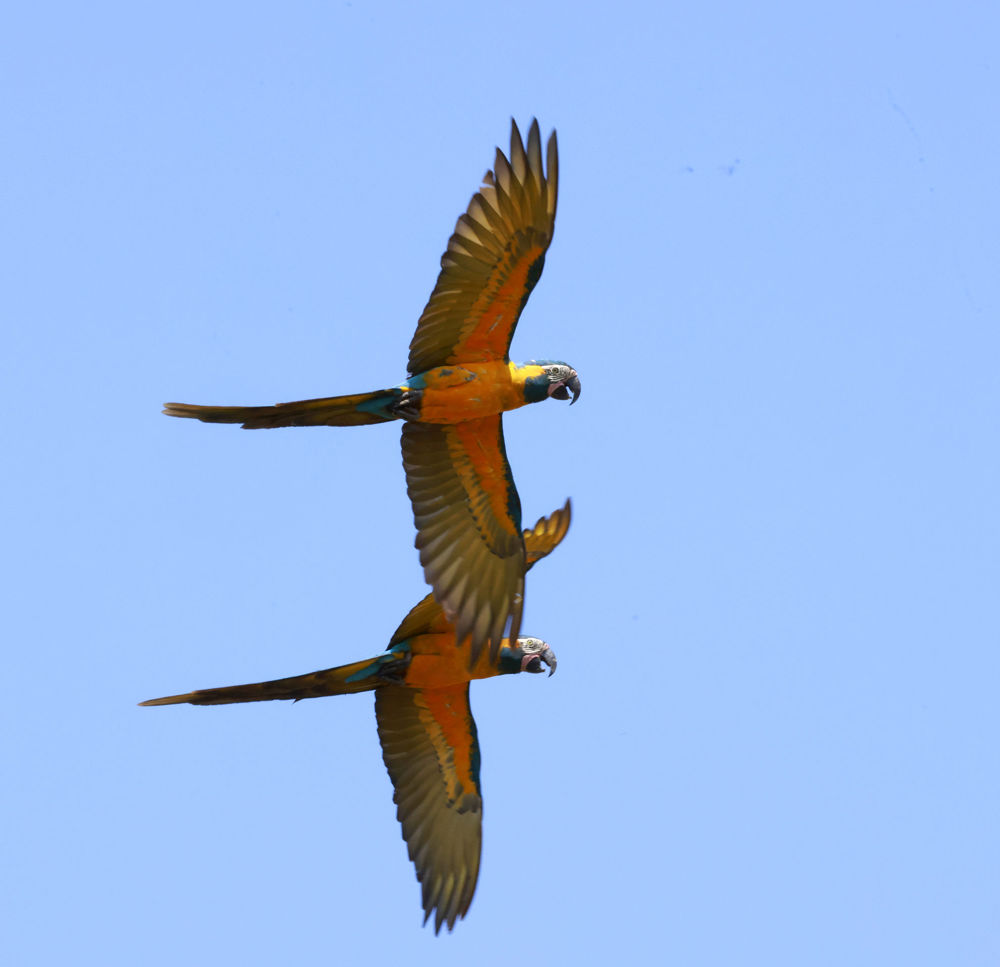
Incredible endemic Blue-throated Macaws © Andrew Whittaker
Enormous thanks must go to the Bolivian conservation organization Armonia for buying and preserving this essential breeding site. As we saw, the nestbox scheme they have carried out with local landowners has been very successful. Other cool birds here included Jabiru stork, charismatic and enormous Southern Screamers, Chestnut-eared Aracari, Red-shouldered and Chestnut-fronted macaws, Campo Flickers, Pale-crested Woodpecker, Little Cuckoo, Sunbittern, Rufous-tailed Jacamar, Great Rufous Woodcreeper, Greater Thornbirds, Red-billed Scythebill (always a favorite), Red-crested Cardinal, Chotoy Spinetail, White and White-rumped monjitas, and Orange-backed Troupial. We also found the near-endemic Rufous (Gray-crested) Cacholote, which Kevin Zimmer and I split from northeastern Brazil’s Caatinga Cacholote and elevated to full-species status in a 2000 paper in the Condor.
The rich marshes of the super-diverse Bolivian Pantanal produced a non-stop stream of birds for us. Outings right on the outskirts of town produced incredible sunset flocks of hundreds of White-faced and Black-bellied whistling-ducks, as well as Brazilian Teal. Other waterbirds were abundant, with the likes of Plumbeous, Buff-necked, Green, and Bare-faced ibis joined by Rufescent Tiger-Heron, stately Maguari Storks, and Roseate Spoonbill. We had wonderful scope studies of Yellow-collared Macaw, Cobalt-rumped Parrotlet, migrant Upland Sandpipers, Savanna Hawk, Aplomado Falcon, Long-winged Harrier, Scarlet-headed Blackbirds, Hudson’s Black-Tyrant, White-bellied and Rusty-collared seedeaters, and the mega-rare Great-billed Seedeater. Always a crowd pleaser, Toco Toucan and Black-capped Donacobius performed its duet. We also relished great looks at the mega-rare form of the Gray-eyed Greenlet, which probably represents a new and undescribed species.
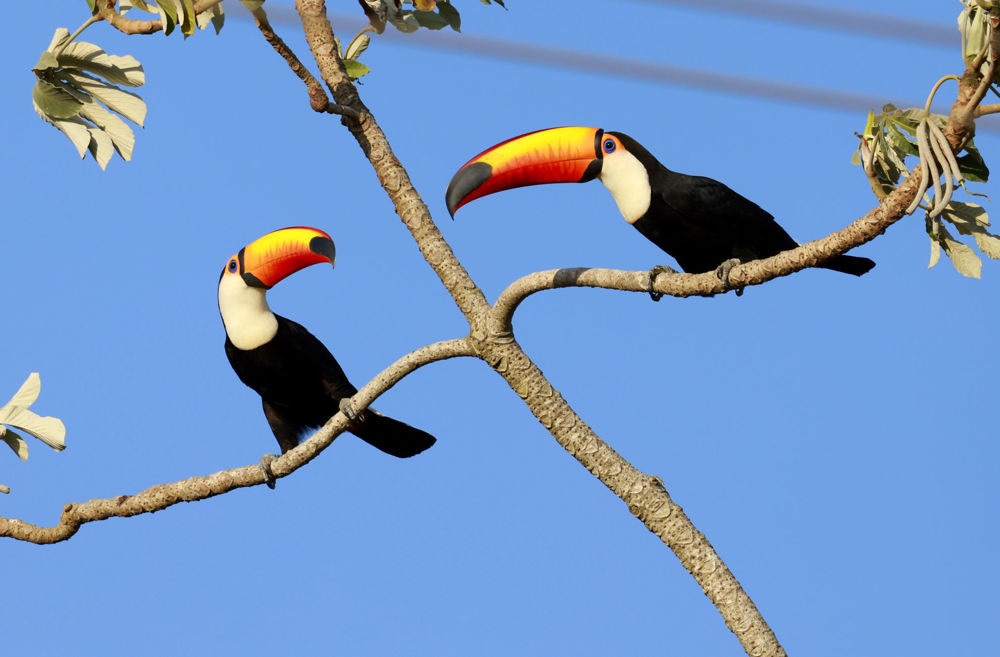
Toco Toucans © Andrew Whittaker
Visits to nearby gallery forest and a private reserve yielded stunning looks at Laughing Falcon, Scarlet Macaw, Blue-crowned Trogon, Hoatzins, Black-fronted Nunbird, Pale-crested Woodpecker, White-wedged Piculet, the endemic form of Plain Softail, Dull-capped Attila, and Yellow-browed Tody-Tyrant. We even found South America’s smallest bird, the Short-tailed Pygmy-Tyrant. One of our best finds was the odd-sounding Sulphur-bellied Tyrant-Manakin, which is extremely locally distributed. And we won’t soon forget those dazzling male Band-tailed Manakins, or the tremendous scope studies of a roosting Great Potoo.
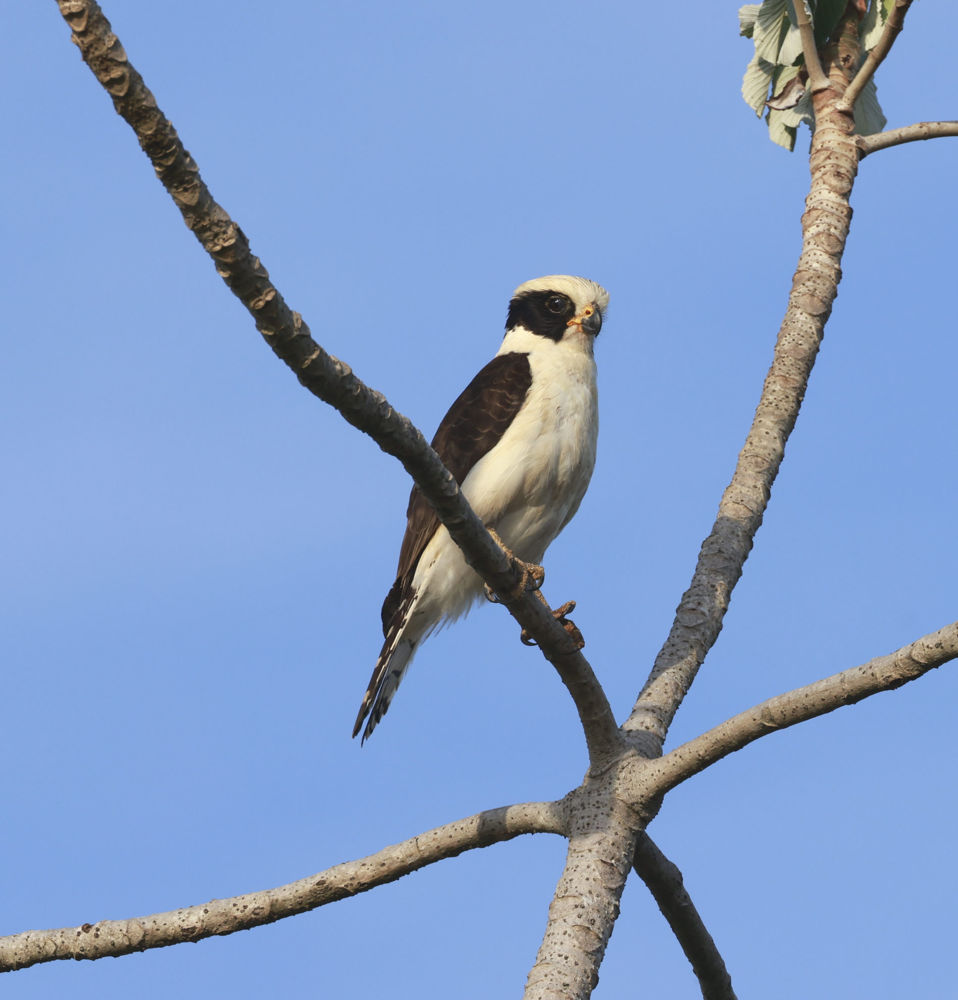
Laughing Falcon © Andrew Whittaker
Our morning boat trip brought us to magnificent encounters with Amazon Pink River Dolphins, herds of Capybara, and even a group of rare Bolivian Red Howlers. Avian highlights included Black-collared Hawk, Slate-colored Hawk, Green Ibis, Wood Stork, Anhinga, Gray-cowled Wood-Rail, Blue-and-yellow Macaws, White-eyed Parakeet, Southern Lapwing, Large-billed Tern, Ringed and Amazon kingfishers, Crimson-crested Woodpecker, White-winged Swallow, and wonderful studies of several pairs of our main objective, the threatened Orinoco Goose.
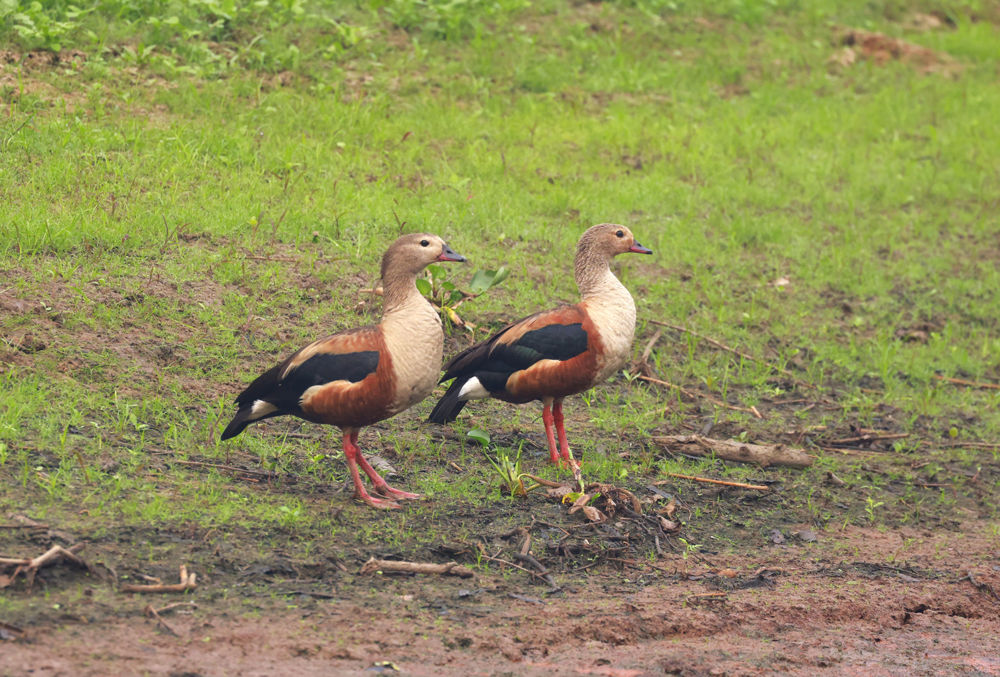
Endangered Orinoco Geese © Andrew Whittaker
Sadly, we had to say goodbye to this mega-rich biome and fly back to Cochabamba, where we said fond farewells to Gary, Kimberlee, and Franta before continuing on an exciting exploration of the Andes and wondrous Lake Titicaca on Part II of our tour.
First and foremost, we have to thank our two outstanding drivers, Marcus and Pepe, plus of course the one and only Indio for his smooth organization and sharp eyes. Last but not least, thanks to all of you for being such a great and fun group! It was a real blast sharing this fabulous country’s wildlife with you all. I am already looking forward to next fall’s return to this exceptional country, which touched all our hearts. I hope that you enjoy reading my report and that it brings back some wonderful memories. Wishing you all happy birding, and I do hope we cross paths again on one of my exciting VENT tours worldwide.
Top 7 favorite birds:
- RED-FRONTED MACAW (ENDEMIC)
- BLUE-THROATED MACAW (ENDEMIC)
- BAND-TAILED MANAKIN
- CRESTED QUETZAL
- YUNGAS MANAKIN
- BOLIVIAN SLATY ANTSHRIKE
- NEW GREENLET
A complete list of the birds recorded on our tour can be found at: https://ebird.org/tripreport/422286
Description for the next departure of this tour.

